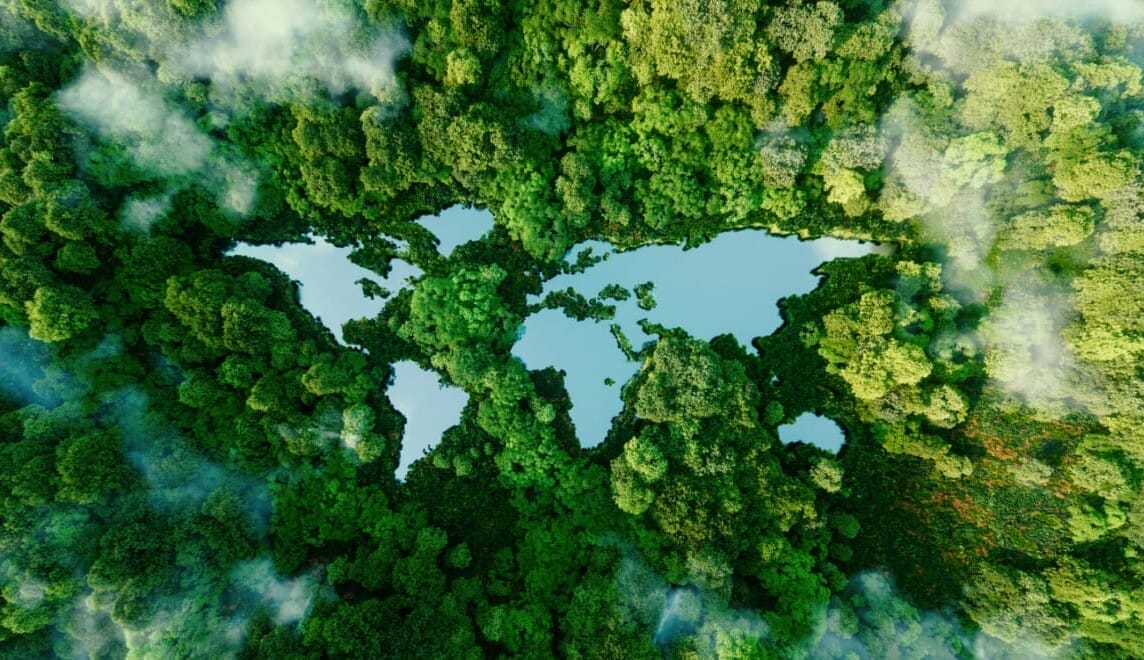Natural capital holds more risk and opportunity than climate change, but where do investors start? Top1000funds.com takes a deep dive exploring the investors that are making inroads to nature-proofing their portfolios.
Natural capital, the store of the world’s natural resources spanning soil to flora, fauna and minerals underpins the global economy providing the world’s food, medicines and built environment. Investors are waking up to the systemic risk and opportunity in its rapid depletion that has the potential to be even bigger than catastrophic climate change. But many struggle with where to start nature-proofing their portfolios.
Getting started
Don’t view natural capital as an asset class, says Brian Kernohan, chief sustainability officer at Manulife Investment Management. The global asset manager, which traces its first investment in timber and agriculture back 40 years, approaches nature on a spectrum that places climate investments alongside traditional inflation-proof real assets and less familiar investments in the circular economy.
“Don’t think about that spectrum as defined buckets, think of it as a wide range of opportunities. A spectrum gives the ability to be creative and build strategies in a blended approach,” he says, using investments like wooden buildings that combine real estate and the circular economy as an example.
The other essential ingredient to getting started is stewardship.
“Investing in nature involves active management to conserve the asset and ensure it persists,” he explains.
Some asset owners are grasping with the concept of a spectrum and blending approach. They are steeling for a wave of nature-related investment products to hit public markets and are exploring bespoke mandates with managers. Examples of other points on the spectrum they are comfortable with include low risk blue and green bonds issued by development banks.
But they struggle to conceive how they can integrate and scale nature investments outside obvious real assets.
Take AP7, the SEK1.3 trillion Swedish buffer fund, which recently got the green light to invest more in illiquid assets. Johan Florén, head of ESG says the fund will develop its allocation to nature in this corner of the portfolio rather than its SEK1.2 trillion equity holdings.
“Illiquids have the best opportunities if you want to contribute,” he says.
Manulife Investment Management’s Kernohan believes one solution lies in supply chain analysis. It’s an area Brightwell, asset manager for the £46.9 billion BT Pension Scheme which has just begun exploring how to integrate nature as part of its thinking on climate and net zero goals also believes is a significant part of the puzzle.
“Supply chains could potentially unlock 80-90 per cent of the nature risk within a portfolio as well as shine light on other sustainability issues such as modern slavery and climate emissions,” says Emma Douglas, who leads on Brightwell’s sustainable investment and stewardship activities.
But accessing corporate supply chain data is a huge task. Douglas believes many corporates still don’t have full transparency of their own supply chains and have only just got to grips with climate reporting; progress in private equity is even slower.
Investors also need systemic processes to analyse supply chain risk.
But the wheels of change are starting to turn. In 2023, AP7 reported on biodiversity across its portfolio for the first time using the Taskforce on Nature-related Financial Disclosures (TNFD) disclosure recommendations, pulling what data it could from the 3,000 companies in its portfolio in a top-down approach that revealed high risk in every sector. Florén is also ploughing his energy into corporate engagement via investor-led group Nature 100+ to push companies to report in line with the recommendations.
He is convinced that although TNFD reporting is still voluntary it will trickle down into corporate reporting standards and is likely to be incorporated into EU legislation in the future. Kernohan also believes companies will increasingly use natural capital accounting methods alongside financial accounting to understand the impact and dependencies on nature.
He says the need to measure nature in the same way that investors have come to measure emissions is perhaps the most important lesson the industry has garnered from climate investment.
“We know we can’t manage what we can’t measure. Climate and carbon have taught us we need an accounting system of the thing we are trying to manage,” says Kernohan.
A different playbook to climate
But commentators also stress important differences between nature and climate investment.
Integrating climate into investment strategies involves reducing one key global metric (carbon) but biodiversity risk is local and involves multiple metrics.
For this reason, and in another distinction from climate, Douglas believes investors in nature should not jump to attach targets before deepening their understanding.
“The metric and target approach investors have adopted to reduce portfolio emissions needs to be adapted to nature but shouldn’t be the first port of call,” she says.
Too narrow targets set too early on could just create more problems, she continues, particularly if investors don’t collaborate with academics. For example, optimising on one (tree planting) could trigger negative consequences (forest monocultures with a negative externality for the local ecosystem) elsewhere.
“If you destroy an existing habitat by planting trees, are you adding to anything?” she asks. Targets can encourage divestment and put a strait jacket on progress, and she also questions investors’ ability to achieve some of the targets they set. “Is it even possible to have a portfolio that is free from modern slavery?”
Putting a price on nature
But for all the distinctions between nature and climate investment, just as in climate, investors will never integrate nature into their portfolios at scale if it equates to lower returns.
The problem is that biodiversity loss is still taken for granted. Valuing nature to a point where the market prices it into a risk adjusted return, coming up with a value proposition for flora and fauna or peat land for example, still feels years away.
Rather than wait for the world to try and solve this complex problem, Kernohan suggests investors put capital to work in one tangible project at a time. This way they can tick off low hanging fruit and find opportunities with real and immediate impact.
Witness how mangrove wetlands on a coastline provide protection from storm surges and hurricanes, he suggests. “You can value mangroves that come with their own biodiversity as a trade off against the catastrophic loss caused by a hurricane. What is the price we incurred by not having nature protect us?”
He is also encouraged by progress in the carbon market where a forest can now be managed for wood and paper outputs, or as a carbon store. “Three years ago, carbon wasn’t valued highly enough to compete as an investment, but this has now changed,” he says.
In another example, the UK government’s high-profile dispute with global investors about the value of water suggests that pricing nature is finally climbing the political agenda.
Investors including C$133 billion Ontario Municipal Employees Retirement System (OMERS) and £75 billion British Universities Superannuation Scheme (USS) cut their losses in troubled UK water utility Thames Water because of demands from Britain’s regulatory authority, OfWat, that they reduce their returns below the cost of capital.
It’s a similar story in Sweden, where Florén argues investors can’t make enough profit because Swedish regulation decrees water infrastructure can only be self-financing. Meanwhile, waste and over-consumption increase because water is cheap.
“The population is not used to paying for water,” he says. “When things are free there is too little investment and over consumption. If there is no financial interest, problems are difficult to solve, and this is also visible in the tragedy of the commons.”
Regulatory risk
The issue reveals how regulatory risk is now a key risk for investors in natural capital. USS recently said its losses in Thames water have shaped its approach to other regulated utilities, calling on the government to recognise the need for investment, and strike a fair balance between risk and returns over the long term.
Moreover, because the concept of investing in nature is new, regulatory frameworks are bound to evolve and change. As the EV sector shows, regulatory course corrections are inherent at the intersection of government and new sectors and concepts, says Manulife Investment Management’s Kernohan.
“Investors will have to consider the risks that the government introduces in the way they manage the regulation,” he says.
Yet in a Catch-22, regulation is also essential: the market won’t find a value for nature without it.
In some ways the regulatory landscape is starting to evolve. AP7’s Florén welcomes the EU ETS, the world’s first carbon market, and notices a new regulatory impetus coming out of Europe from tree planting to river restoration.
Other investors agree.
“If governments send the right signal, the market will respond,” says Douglas, who stresses regulators should incentivise not punish.
Regulation, says Kernohan, could involve policymakers taking stock of natural capital at a government level to understand if it is increasing or decreasing.
“Perhaps they could do it in the same way as they measure GDP,” he concludes, reflecting on what the future could look like.
“Governments could create a metric that is an indicator of natural capital wealth and allows it to track natural capital. Natural capital underpins economies, but it has become an externality and an input to growth whereby nature actually declines at the expense of a single financial metric, GDP.”


